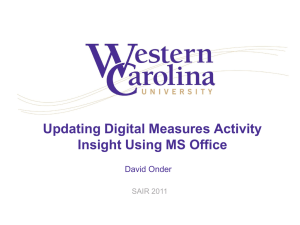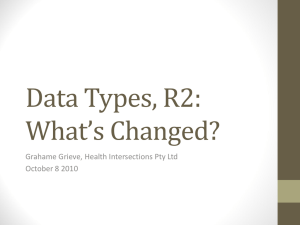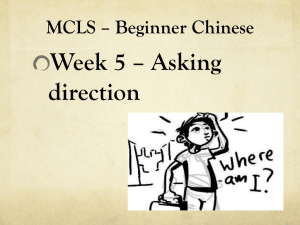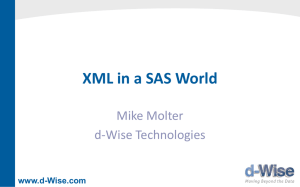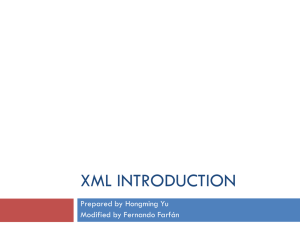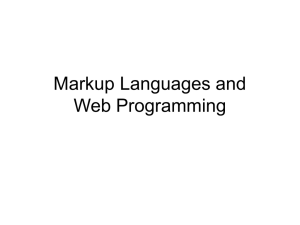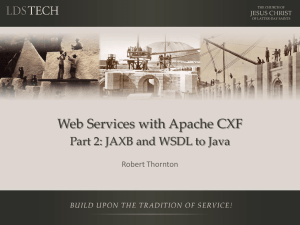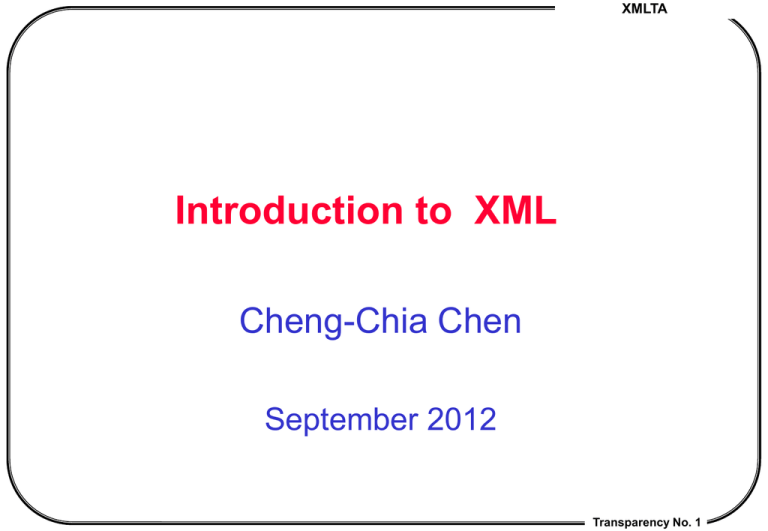
XMLTA
Introduction to XML
Cheng-Chia Chen
September 2012
Transparency No. 1
XML Introduction
contents
What is XML ?
Where does XML come from? What is its status?
Why do we need XML ?
XML v.s Other formats
Core XML Specifications and APIs
How can we do with XML?
XML sites
A partial list of XML applications and industry
initiatives
a sketch of XML documents
Transparency No. 2
XML Introduction
What is XML ?
The eXtensible Markup Language
a data-structure definition language : let you define the
structure and format of your own data.
a data format (syntax) used for the representation, storage
and transmission of data whose format is defined by xml.
Text-based markup Language, let you define your own
HTML-like markup languages.
Recommended by World Web Consortium (W3C) in Feb
1998.
intended to be used as a new message format over the
Internet to complement the inadequacy of HTML.
a subset of SGML
is now very popular and becomes the dominating
interchange format of information over the
IT/internet.
Transparency No. 3
XML Introduction
The idea of XML
Existing student information
S9010 張得功 資科系 三年級 chang10@cs.nccu.edu.tw
S9021 王德財 應數系 二年級 null
…
Transparency No. 4
XML Introduction
HTML’s concerns
How to present the data:
學號
姓名
科系
年級
電郵
S9010
張得功
資科系
三年級 chang10@cs.nccu.edu.tw
s9021
王德財
應數系
二年級
<TABLE BORDER=1 bgcolor=“yellow” >
<TR><TH>學號</TH>姓名<TH>科系</TH> <TH>年級</TH>
<TH>電郵</TH> </TR>
<TR><TD> S9010</TD><TD>張得功</TD> <TD>資科系</TD>
<TD>三年級</TD> <TD> chang10@cs.nccu.edu.tw </TD></TR>
<TR> <TD> S9021 </TD> <TD>王德財</TD> <TD>應數系 </TD>
<TD>二年級 </TD> </TR>
</TABLE>
Transparency No. 5
XML Introduction
XML’s concerns
XML uses markup tags as well, but, describe the content,
rather than the presentation of that content.
the same example coded in XML:
<students>
<student><學號> S9010 </學號> <姓名>張得功</姓名> <科系>資科系</科系>
<年級>三年級</年級>
<電郵> chang10@cs.nccu.edu.tw </電郵> </student>
<student><學號> S9021 </學號> <姓名>王德財</姓名> <科系>應數系 </科系>
<年級>二年級 </年級><電郵/> </student>
…
</students>
Notes:
1. Only contents are encoded in the XML text.
2. All data are annotated by tags indicating their roles or
functions in the message.
Transparency No. 6
XML Introduction
Where does XML come from ?
a simplified subset of the Standard Generalized
Markup Language (SGML) standardized in 1986,
based on the Generalized Markup Language
invented by IBM in 1969
simplified for more general use on the Web and
as a data interchange format.
without losing extensibility,
easier for anyone to write valid XML.
easier to write a parser
easier for the parser to quickly verify that documents are
well-formed and/or valid.
1.0 recommended by W3c at Feb. 1998.
1.1 recommended at Feb. 2004.
Transparency No. 7
XML Introduction
What is the status of XML?
A pervasive data formats over internet as well as other IT
fields.
embraced by all of the leaders in the computer industry.
many vertical industries are embracing XML for its ability to expedite
the availability of their domain-specific information for internal and
external use.
IBM, Microsoft, Sun, Oracle, HP, …
There are many W3C-proposed extensions to XML.
Most use the XML language, which minimizes the differences in syntax
that must be learned.
See
XML at W3c or
The XML Cover Pages
for most up-to-date information.
Transparency No. 8
XMLTA
Why do we need XML ?
or What can XML bring us?
Transparency No. 1
XML Introduction
XML unifies the syntax of information
Layer of information(data):
bit
byte
character
BCD EBCDIC ASCII BIG5 ISO-8859 ==>
UNICODE
syntax(form)
XML
semantics (ontology)
Semantic Web
Application
Semantic Web:
an extension of the current web in which information is
given well-defined meaning, better enabling computers
and people to work in cooperation.
--- Tim Berners-Lee et.al.
Transparency No. 10
XML Introduction
Dtata/Information Requirements in the internet age
Easy retrieval of information over the internet
realized by current (non-XML) Web/internet technology
good browser,
web server
HTTP, DNS, search engines.
HTML, URI, HyperText, MIME
Easy/cheap interoperation of existing softwares in the
internet. XML + web service
also the old goal of distributed system/computing
RPC, RMI, CORBA,...
a prerequisite for eCommerce
issues:
data transmission ==> solved by existing internet infrastructure
data representation/interpretation ?
Transparency No. 11
XML Introduction
Why needing a unifying format for data ?
Case: 10 word processors, each needs to be able to
process docs generated by any other.
1st approach:
write a converter A-->B for any A and B.
#converter = n x (n-1) = 90 (bad!)
2nd approach:
invent a common format (C).
write a pair of converters (A --> C, C-->A) for each word
processor.
To process doc generated from A by B, simply
A --(A-->C)-- C -- (C-->B) -- B
required converts: 2 x n = 20 (much better!)
prerequisite: need a common format.
This is what XML plays!!
Transparency No. 12
XML Introduction
Example:XML in EDA (Electric Design Automation)
Transparency No. 13
XML Introduction
Additional benefits of XML (as a common format)
Free (or cheap) cost of obtaining required software
for processing XML.
without the need to reinvent the wheel.
can focus on value-added software based on these
underlying software.
Decoupling of tightly-coupled distributed systems
into loosely one.
less monopolization of software by vendors
more selections of combinations for buyers
more chances of contributing softwares for small
company.
less investment for buyers.
Transparency No. 14
XML Introduction
Application types of World-Wide Web
Three-tier WWW architecture :
Major information flows (for human information
retrieval):
(human) browser
--(http)--> webServer
--> databases -->wrap result into html or
other MIME formats
--(http) ---> browser --> human
major interactions and interchanged data formats:
application type: information retrieval
Man ---(html/MIME)--- machine(browser+web server)
web server ------------ backend system (databases)
Transparency No. 15
XML Introduction
client browser
query(post,get)
http
IE
client browser
FireFox
html/text
gif/jpeg
video/audio
web server
the internet
...
client browser
...
web server
apache
file
system
databases
web server
IIS
file
system
result
tables
file
system
query
databases
databases
Transparency No. 16
XML Introduction
The other type of WWW applications: business applications
Transparency No. 17
XML Introduction
Additional Interactions for WWW business applications
New application type : web service
additional interactions
backend business system <---> webserver <--> webserver
<---> backend business system
Problem: Too many data formats exist among the
systems and web servers understanding all kinds of
data formats are hard to implement.
Solution: define a universal or a small set of
universal data formats (in XML) and require all
systems to transmit data using such formats.
but the existing HTML + MIME formats not enough ?
NO!! HTML, while amendable to human via browsers, is
not easy for machine to understand/retrieve data.
Transparency No. 18
XML Introduction
Advantages of XML over HTML
XML can define your own tags.
XML tags describe the content, rather than the
presentation of that content
easier for content search (no annoying presentation data).
easier for page development (separating content from
view)
easy for devices to render the contents depending on its
environments (single model/multiple views)
Notes for the next figure:
searches can be applied to XML data more easily, and the
result can be rendered differently, depending on the
destination device.
the XML processor can exist on the server, the client, or
both.
Transparency No. 19
XML Introduction
work done by the XML processor in response to a client request:
1. collect data from related data sources
2. merge sources into a unifying content
3. rendering data depending on the client’s environment.
Transparency No. 20
XML Introduction
Comparison of XML and Other formats
HTML
discussed
Text-based non-markup formats
.c .cpp .java .ini …
Binary formats
.dll
.exe .o
.swf
.class .png .jpeg …
runtime system/language objects
Java objects, C# /C++ objects
C data structures,…
New alternatives to XML
JSON, MicroXML
Transparency No. 21
XML Introduction
Advantage of XML over text formats
Ex:
JavaML v.s Java; CppML v.s Cpp
XMI v.s rational’s proprietary format
web.xml, plugin.xml v.s ***.ini (for configuration)
build.xml v.s. makefile
XQuery XML format v.s plain text format
RelaxNG XML v.s. plain text format
advantage:
structure explicitly represented in the XML format.
(free and) standard tools (and API) exists for quick parsing of the XML
format. => front-end processing avoided/reduced
disadvantage: too verbose.
for storage and transmission.
can be overcome by compression
for human generation; (not a problem for machine generation)
require smarter editor
for human reading/comprehension:
a real problem!!
Transparency No. 22
XML Introduction
Advantage of XML over binary formats
Example:
classML v.s .clss file format.
swfml v.s swf (Flash file format)
XER v.s. BER for ASN.1
advantage:
readable; editable
(free and) open software and APIs available
disadvantage:
take longer time to parse and transmit.
The trend:
one data model/ multi representation formats +
converters among the formats.
Transparency No. 23
XML Introduction
Advantages of XML over system/langauge specific formats
Example:
XML v.s Java objects v.s C# objects v.s …
disadvantages :
poor performance;
more inconvenient to represent and program
advantages:
unifying format (cross language/system) web service
interchangeable
persistency
Transparency No. 24
XML Introduction
Core specifications for XML
XML 1.0
XML Namespace
XML Path language (XPath)
XML Stylesheet Langugae (XSL)
XSL Transformation language (XSLT)
XSL formating Objects (XSLFO)
XML Linking language (XLink)
XML Pointer Langugae (XPointer)
XMLForm
XML schemas (; RelaxNG)
XHTML
XQuery (XML language for Querying XML Documents)
Security: XML encryption/signatures/canonicalization/XKMS
Publishing:XML-FO, SVG, MathML
XML protocols (soap) part of webservice activity.
Transparency No. 25
XML Introduction
Core Specifications for XML
XML
document type definition (DTD) : a utility used to define the formats
and contents of valid XML documents.
a specification to define what kinds of texts are well-formed XML
document
XML namespace
Define a mechanism to avoid collision of elements and/or attribute
names in documents using multiple sets of DTDs.
Xlink
Define the mechanism for linking to web resources from an XML
document.
Xpointer
Define a mechanism for linking to inside an XML document.
XPath
Define a mechanism to refer to part of an XML document
Transparency No. 26
XML Introduction
XSL ( XML Stylesheet Language)
a language for expressing stylesheets.
consists of two parts:
XSLT : a language (in XML format) used to describe how
to transform an XML document into one in XML or nonXML format.
XSLFO: an XML vocabulary for specifying formatting
semantics.
An XSL stylesheet specifies the presentation of a
class of XML documents by describing how an
instance of the class is transformed into an XML
document that uses the formatting vocabulary.
Transparency No. 27
XML Introduction
Transparency No. 28
XML Introduction
XML Schema
A planned replacement of DTD.
used to define the structures and formats of various
messages encoded in XML format.
another competing alternative: RelaxNG
consists of three documents:
Part 0: a primer
an easy-to-understand introcuction
Part 2: Datatypes
define tens of frequently used bulit-in datatypes
Part 3: structures
specifies the XML Schema definition language, offers facilities
for describing the structure and constraining the contents of XML
documents
Transparency No. 29
XML Introduction
API for XML documents
DOM (level 1 , 2 & 3) :
Document Object Model
Tree-based XML API
language independent
SAX (version 1 & 2) :
Simple API for XML Document,
Event-based XML API
JDOM, dom4j, XOM (XML APIs for Java)
DOM for Java
Tree-based,
simpler version of DOM
easier to use than DOM,
suitable for Java only
Transparency No. 30
XML Introduction
How can XML be used ?
XML was designed to store, carry and exchange data. It was
not designed to display data.
As a syntax format:
XML is used to Exchange Data
With XML, data (ex:SOAP messages)can be exchanged
between incompatible systems.
XML and B2B : With XML, financial information(ex: XBRL)
can be exchanged over the Internet.
XML can be used to Share Data
With XML, plain text files can be used to share data.
XML can be used to Store Data
With XML, plain text files (XMI, java XML persistency
formats)can be used to store data and object.
As a meta language (for defining data structure)
XML can be used to Create new Languages
XML is the mother of Adobe Flex, javaFX, WML, SVG, SMIL,
GXL, XHTML, CML, OpenOffice, Microsoft Office,...
Transparency No. 31
XML Introduction
XML can make your Data more Useful
With XML, your data is available to more users.
For sensible developers
All sensible developers should have all their
future applications exchange data in XML.
Transparency No. 32
XML Introduction
What can we do about XML
XML processing tools:
XML parser; XML editors; XML-existing format converter
XML2HTML; DTD2DCD ; DCDeditor
Various Domain-specific XML rendering tools
graphical XML --> Graphic
DTD manager, schema tools, soap processor, web service
tools/IDE/system
XML-enabled services/applications:
make your application software capable of serving
request from internet (without special prerequisite) and
requesting other internet on-line service.
Transparency No. 33
XML Introduction
What can we do about XML ?
XML document design/application development
Design standard XML vocabulary for various domains
order, transaction, billing, product for business domain
mathematical formula, chemical formula in science
Graph/graphics markup language ; Others: ?
academic artifacts: OODesign (XMI), graph(GXL), petriNet, java
Object (XML encoding), AST,...
require cooperation of XML experts and domain experts.
XMLize legacy system data/database
domain:一般企業: 之 人事 庫存 客戶 產品 產品使用手冊 公文; 醫院 學校
政府機關(戶政 地政 稅捐...) : 病例 藥品 課程 戶籍 地籍 稅務
Approaches:
– change old format to new XML format, and optionally, provide a view
of old format.
– two formats coexisting.
– preserve old format, provide a new XML view.
Transparency No. 34
XML Introduction
XML information
Information sources for XML:
W3C site: http://www.w3.org/
SGML/XML home page: http://xml.coverpages.org/
XML com: http://www.xml.com/
XML page of leading computer companies
Microsoft: http://www.microsoft.com/xml/
IBM: http://www.ibm.com/developer/xml/
sun: http://java.sun.com/xml
…
Transparency No. 35
XML Introduction
XML applications ()
XML as an alternative representation format
(SVG) Scalar Vector Graph : for vector graph
(MathML) : for mathematical expressions
SMIL (Synchronized Multimedium Integration language):
Resource Description Framework (RDF) : an XML language for
describing web resources and their relationship
CML (Chemical Markup Language) : for chemical molecule
JCML : XML format for java bytecodes (object code)
JavaML : for java programs
CppML : XML formats for C++
Ant : a replacement of make for java
OOML : a OO PL in XML
UIML : user interface Markup language
WAP WML (Wireless Markup Language)
Transparency No. 36
XML Introduction
A partial list of XML applications and industry initiatives
W3C Specifications Documentation
Text Encoding Initiative (TEI)
XCES: Corpus Encoding Standard for XML
Encoding and Markup for Texts of the Ancient Near East
Electronic Text Corpus of Sumerian Literature (ETCSL)
Perseus Project
Channel Definition Format, CDF (Based on XML)
RDF Rich Site Summary (RSS)
Open Content Syndication (OCS)
Web Modeling Language (WebML)
Portable Site Information (PSI)
XHTML and 'XML-Based' HTML Modules
W3C Document Object Model (DOM), Level 1 Specification
Web Collections using XML
Meta Content Framework Using XML (MCF)
XML-Data
Namespaces in XML
Resource Description Framework (RDF)
Ontology Interchange Language (OIL)
The Australia New Zealand Land Information Council (ANZLIC) - Metadata
Alexandria Digital Library Project
ATLA Serials Project (ATLAS)
Transparency No. 37
XML Introduction
XML in law
BiblioML - XML for UNIMARC Bibliographic Records
Medlane XMLMARC Experiment - MARC to XML
e-Government Interoperability Framework (e-GIF)
US Federal CIO Council XML Working Group
XML Metadata Interchange Format (XMI) - Object Management Group (OMG)
OMG Common Warehouse Metadata Interchange (CWMI) Specification
Object Management Group XML/Value RFP
MDC Open Information Model (OIM)
Dublin Core Metadata Initiative (DCMI)
Open Archives Metadata Set (OAMS)
Publishing Requirements for Industry Standard Metadata (PRISM)
Platform for Internet Content Selection (PICS) XML and Petri Nets
Outline Processor Markup Language (OPML)
ParlML: A Common Vocabulary for Parliamentary Language
Legal XML Working Group
COSCA/NACM JTC XML Court Filing Project
New Mexico District Court XML Interface (XCI)
Transparency No. 38
XML Introduction
XML and multimedia
Synchronized Multimedia Integration Language (SMIL)
Multimodal Presentation Markup Language (MPML)
Moving Picture Experts Group: MPEG-7 Standard
DIG35: Metadata Standard for Digital Images
W3C Scalable Vector Graphics (SVG)
Precision Graphics Markup Language (PGML)
Vector Markup Language (VML)
Image Markup Language (IML)
VRML (Virtual Reality Modeling Language) and X3D
Extensible Graph Markup and Modeling Language (XGMML)
Structured Graph Format (SGF)
Graph Exchange Language (GXL)
Petri Net Markup Language (PNML)
Transparency No. 39
XML Introduction
XML in chemistry and biochemistry
Georgia State University Electronic Court Filing Project
Web Standards Project (WSP)
Open Software Description Format (OSD)
XLF (Extensible Log Format) Initiative
ALURe (Aggregation and Logging of User Requests) XML Specification
Apache XML Project
WAP Wireless Markup Language Specification
The SyncML Initiative
Materials Property Data Markup Language (MatML)
Measurement Units Markup Language
XML-Based 'eStandard' for the Chemical Industry
Chemical Markup Language
Molecular Dynamics [Markup] Language (MoDL)
StarDOM - Transforming Scientific Data into XML
Bioinformatic Sequence Markup Language (BSML)
BIOpolymer Markup Language (BIOML)
CellML
Gene Expression Markup Language (GEML)
Genome Annotation Markup Elements (GAME)
Transparency No. 40
XML Introduction
XML and Finance
Microarray Markup Language (MAML)
XML for Multiple Sequence Alignments (MSAML)
Systems Biology Markup Language (SBML)
OMG Gene Expression RFP
Taxonomic Markup Language
XDELTA: XML Format for Taxonomic Information
Virtual Hyperglossary (VHG)
Weather Observation Definition Format (OMF)
Open Philanthropy Exchange (OPX)
Open Financial Exchange (OFX/OFE)
Interactive Financial Exchange (IFX)
FinXML - 'The Digital Language for Capital Markets'
Investment Research Markup Language (IRML)
Extensible Financial Reporting Markup Language (XFRML)
Extensible Business Reporting Language (XBRL)
XMLPay Specification
Trading Partner Agreement Markup Language (tpaML)
Internet Open Trading Protocol (IOTP)
Financial Products Markup Language (FpML)
Transparency No. 41
XML Introduction
XML messaging ( or XML Protocols)
XML Mail Transport Protocol (XMTP) for XML SMTP and MIME Representation
HTML Threading - Use of HTML in Email
XML Messaging (IETF)
Jabber XML Protocol
XML Messaging Specification (XMSG)
M Project: Java XML-Based Messaging System
HTTP Distribution and Replication Protocol (DRP)
Information and Content Exchange (ICE)
Transparency No. 42
XML Introduction
FAML DTD for Financial Research Documents
Mortgage Bankers Association of America MISMO Standard
Digital Property Rights Language (DPRL)
Extensible Rights Markup Language (XrML)
Open Digital Rights Language (ODRL)
Research Information Exchange Markup Language (RIXML)
Data Link for Intermediaries Markup Language (daliML)
XML-MP: XML Mortgage Partners Framework
EcoKnowMICS ML
Electronic Book Exchange (EBX) Working Group FIXML - A Markup Language for
the FIX Application Message Layer
Bank Internet Payment System (BIPS)
smartX ['SmartCard'] Markup Language (SML)
Transparency No. 43
XML Introduction
Secure XML
XML and Encryption
XML Digital Signature (Signed XML - IETF/W3C)
XML Key Management Specification (XKMS)
Security Services Markup Language (S2ML)
AuthXML Standard for Web Security
Digital Signatures for Internet Open Trading Protocol (IOTP)
XML Encoding of SPKI Certificates
Digital Receipt Infrastructure Initiative
Digest Values for DOM (DOMHASH)
Signed Document Markup Language (SDML)
Transparency No. 44
XML Introduction
Real Estate Transaction Markup Language (RETML)
OpenMLS and RELML (Real Estate Listing Markup Language)
Data Consortium (Real Estate Standards)
Comprehensive Real Estate Transaction Markup Language (CRTML)
ACORD - XML for the Insurance Industry
iLingo XML Schemas for Insurance
Customer Profile Exchange (CPEX) Working Group
Customer Support Consortium
XML for the Automotive Industry - SAE J2008
Spacecraft Markup Language (SML)
XML.ORG - The XML Industry Portal
X-ACT - XML Active Content Technologies Council
Electronic Business XML Initiative (ebXML)
BASDA eBIS-XML
Portal Markup Language (PML)
EDGARspace Portal
DII Common Operating Environment (COE) XML Registry
StarOffice XML File Format
Open eBook Initiative
ONIX International XML DTD
NISO Digital Talking Books (DTB)
Transparency No. 45
XML Introduction
OpenMath Standard
OMDoc: A Standard for Mathematical Documents
Mathematical Markup Language
Re-Useable Data Language (RDL)"
OpenTag Markup
Metadata - PICS
MIX - Mediation of Information Using XML
CDIF XML-Based Transfer Format Covad xLink API (XML-Based DSL
Provisioning)
WebBroker: Distributed Object Communication on the Web
Web Interface Definition Language (WIDL)
Global Engineering Networking Initiative (GEN)
XML/EDI - Electronic Data Interchange
XML/EDI Repository Working Group
Transparency No. 46
XML Introduction
Global Uniform Interoperable Data Exchange (GUIDE)
BizCodes Initiative
Universal Data Element Framework (UDEF)
European XML/EDI Workshop
EEMA EDI/EC Work Group - XML/EDI
ANSI ASC X12/XML and DISA
OpenTravel Alliance (OTA)
Hospitality Industry Technology Integration Standards (HITIS) Project
Open Catalog Protocol (OCP)
eCatalog XML (eCX)
vCard Electronic Business Card
Customer Identity / Name and Address Markup Language (CIML, NAML)
AND Global Address XML Definition
Historical Event Markup and Linking
iCalendar XML DTD
Transparency No. 47
XML Introduction
EC FrameWorks
CommerceNet Industry Initiative
eCo Interoperability Framework Specification
BizTalk Framework
eCo Framework Project and Working Group
Commerce XML (cXML)
SMBXML: An Open Standard for Small to Medium Sized Businesses
RosettaNet
Transparency No. 48
XML Introduction
XML Encoded Form Values
Capability Card: An Attribute Certificate in XML
Telecommunications Interchange Markup (TIM, TCIF/IPI)
aecXML Working Group - Architecture, Engineering and Construction
Building Construction Extensible Markup Language (bcXML)
MasterBuilder Construction Management and Accounting
Green Building XML (gbXML)
Product Data Markup Language (PDML)
Product Definition Exchange (PDX)
Electronic Component Information Exchange (ECIX) and Pinnacles Component Information
Standard (PCIS)
ECIX QuickData Specifications
ECIX Component Information Dictionary Standard (CIDS)
ECIX Timing Diagram Markup Language (TDML)
XML and Electronic Design Automation (EDA)
Encoded Archival Description (EAD)
UML eXchange Format (UXF)
XML Data Binding Specification
Translation Memory eXchange (TMX)
P3P Specification: Platform for Privacy Preferences
Extensible Name Service (XNS)
Dialogue Moves Markup Language (DMML)
Transparency No. 49
XML Introduction
Scripting News in XML
InterX.org Initiative
Document Encoding and Structuring Specification for Electronic Recipe Transfer
(DESSERT)
NuDoc Technology
Coins: Tightly Coupled JavaBeans and XML Elements
DMTF Common Information Model (CIM)
Universal Plug and Play Forum
XML Transition Network Definition (XTND)
Process Interchange Format XML (PIF-XML)
(XML) Topic Maps
DARPA Agent Mark Up Language (DAML)
Rule Markup Language (RuleML)
Relational-Functional Markup Language (RFML)
Ontology and Conceptual Knowledge Markup Languages
Information Flow Framework Language (IFF)
Simple HTML Ontology Extensions (SHOE)
XOL - XML-Based Ontology Exchange Language
Description Logics Markup Language (DLML)
Case Based Markup Language (CBML)
Artificial Intelligence Markup Language (AIML)
Physics Markup Language (PhysicsML)
Transparency No. 50
XML Introduction
Procedural Markup Language (PML)
QAML - The Q&A Markup Language
LACITO Projet Archivage de données linguistiques sonores et textuelles [Linguistic Data
Archiving Project]
Geography Markup Language (GML)
LandXML
Navigation Markup Language (NVML)
Extensible Data Format (XDF)
Gemini Observatory Project
NASA Goddard Astronomical Data Center (ADC) 'Scientific Dataset' XML
Extensible Scientific Interchange Language (XSIL)
Object Oriented Data Technology (OODT) and XML
Astronomical Markup Language
Astronomical Instrument Markup Language (AIML)
GedML: [GEDCOM] Genealogical Data in XML
adXML.org: XML for Advertising
Newspaper Association of America (NAA) - Standard for Classified Advertising Data
News Industry Text Format (NITF)
XMLNews: XMLNews-Story and XMLNews-Meta
NewsML and IPTC2000
News Markup Language (NML)
Notes Flat File Format (NFF)
Transparency No. 51
XML Introduction
Java Help API
Cold Fusion Markup Language (CFML)
Document Content Description for XML (DCD)
XSchema
Document Definition Markup Language (DDML)
Character Mapping Markup Language (CharMapML)
WEBDAV (IETF 'Extensions for Distributed Authoring and Versioning on the World Wide
Web')
DAV Searching and Locating (DASL)
Graphic Communications Association - GCA 'Paper' DTD
DocBook XML DTD
Apache Cocoon JavaDoc Documentation in XML
JDox: XML Format for Sun Javadoc
XML for Publishers and Printers (XPP)
Job Definition Format (JDF)
Printing Industry Markup Language (PrintML)
PML: Markup Language for Paper and Printing
PrintTalk Consortium
printcafe eProduction eCommerce eXchange (PCX)
IEEE LTSC XML Ad Hoc Group
Universal Learning Format Technical Specification
Transparency No. 52
XML Introduction
Educom Instructional Management Systems Project (IMS) Metadata Specification
Learning Material Markup Language (LMML)
Tutorial Markup Language (TML)
International Development Markup Language (IDML)
Call Processing Language (CPL)
Call Policy Markup Language (CPML)
VoiceXML Forum (Voice Extensible Markup Language Forum)
VoxML Markup Language
Telephony Markup Language (TML)
DARPA Communicator Project and XML Log Standard
Multilevel Annotation, Tools Engineering (MATE)
Computing Environment for Linguistic, Literary, and Anthropological Research (CELLAR)
Architecture and Tools for Linguistic Analysis Systems (ATLAS)
TalkBank and the Codon XML-Based Annotation Framework
ACE Pilot Format DTDs
Transcriber - Speech Segmentation and Annotation DTD
Natural Language Semantics Markup Language
Extensible Telephony Markup Language (XTML)
SABLE: A Standard for Text-to-Speech Synthesis Markup
Speech Synthesis Markup Language Specification for the Speech Interface Framework
Java Speech Markup Language (JSML/JSpeech)
SpeechML
Transparency No. 53
XML Introduction
TalkML
Project Management XML Schema
XML for Workflow Management [NIST]
SWAP - Simple Workflow Access Protocol
XML-Based Workflow [Process Management] Standard: Wf-XML
Exchangeable Routing Language (XRL)
Architecture Description Markup Language (ADML)
Theological Markup Language (ThML)
LitML: A Liturgical Markup Language
XML-F ('XML for FAX')
XML and Forms
XHTML-FML: Forms Markup Language
Extensible Forms Description Language (XFDL)
XML Forms Architecture (XFA)Electronic Form System (EFS)
Broadcast Hypertext Markup Language (BHTML)
IEEE Standard DTD
Open Settlement Protocol (OSP) - ETSI/TIPHON
Directory Services Markup Language (DSML)
DIF Directory Interoperability Proposal
XML DTD for ACAP - ACAP Data Interchange Format
WDDX - Web Distributed Data Exchange
XIOP - XML Corba Environment-Specific Inter-ORB Protocol
Transparency No. 54
XML Introduction
XML-RPC
Blocks eXtensible eXchange Protocol Framework (BEEP)
Layered Object Transport Protocol (LOTP)
XML for Exchange of Structure and Identification of Management Information (SMI)
WorldOS
Business Process Modeling Language (BPML)
Business Rules Markup Language (BRML)
Common Business Library (CBL)
Universal Commerce Language and Protocol (UCLP)
VISA XML Invoice Specification
First Retail Mark-up Language
Open Applications Group - OAGIS
Schema for Object-oriented XML (SOX)
XMLTP.Org - XML Transfer Protocol
The XML Bookmark Exchange Language (XBEL)
Simple Object Definition Language (SODL) and XMOP Service
Simple Object Access Protocol (SOAP)
Universal Description, Discovery, and Integration (UDDI)
Web Services Description Language (WSDL)
Extensible Provisioning Protocol (EPP)
Transaction Authority Markup Language (XAML)
XML Encoding Rules for ASN.1 (XER)
Transparency No. 55
XML Introduction
Object-Oriented Programing Meta-Language (OOPML)
XML and Music
FlowML: A Format for Virtual Orchestras
Clinical Data Interchange Standards Consortium
National Library of Medicine (NLM) XML Data Formats
ISIS European XML/EDI Healthcare Pilot Project (XMLEPR)
Open Healthcare Group 'XChart'
DocScope: Open Source XML Healthcare Project
Health Level Seven XML Patient Record Architecture
ASTM XML Document Type Definitions (DTDs) for Health Care
The CISTERN Project - Standard XML Templates for Healthcare
Template Definition Language (TDL)
Human Resource Management Markup Language (HRMML)
HR-XML Consortium
XML-HR Initiative - Human Resources
Rosetta Group XML Résumé Library
ECMData - Electronic Component Manufacturer Data Sheet Inventory Specification
Bean Markup Language (BML)
The Koala Bean Markup Language (KBML)
Jigsaw XML Format (JigXML)
Chinese XML Now!
MOS-X (Media Object Server - XML)
Transparency No. 56
XML Introduction
FLBC (Formal Language for Business Communication) and KQML
ISO 12083 XML DTDs
Electronic Thesis and Dissertation Markup Language (ETD-ML)
Extensible User Interface Language (XUL)
The Extensible Bindings Language (XBL)
User Interface Markup Language (UIML)
Process Specification Language (PSL) and XML
Steel Markup Language (SML)
Energy Trading Standards Group (ETSG)
Petrotechnical Open Software Corporation (POSC) XML Related Projects
PetroXML Initiative
Partner Interface Process for Energy (PIPE)
Marine Trading Markup Language (MTML)
Navy CALS Initiatives XML
eFirst XML for Scholarly Articles
XML DTD for Phone Books
Using XML for RFCs
Schools Interoperability Framework (SIF)
Guideline XML (gXML)
Extensible Protocol
XML Belief Network File Format (Bayesian Networks)
Transparency No. 57
XML Introduction
Predictive Model Markup Language (PMML)
Data Documentation Initiative: A Project of the Social Science Community
XML and 'The Semantic Web'
XML and Attribute Grammars
XML and Databases
SODA2 - An XML Semistructured Database System
RAX - Record API for XML
XML and CORBA
Chess Markup Language (ChessML)
Mind Reading Markup Language (MRML)
Transparency No. 58
XML Introduction
A sketch of the XML Syntax
XML is a simple data format that balances
the needs of people to read/write data with
the needs of machines to read/write data.
-- Dan Connolly, W3C
Transparency No. 59
XML Introduction
A sketch of XML Syntax
An example XML document:
<?xml version="1.0"?>
<note>
<to>Wang</to>
<from>Chen</from>
<heading>Reminder</heading>
<body>Don't forget me this weekend!</body>
</note>
Notes:
1. The XML declaration should always be included.
2. <note>…</root> is the root element which has 4
children.
Transparency No. 60
XML Introduction
<!– the structure of the document element -->
<department>
<employee id=“s8931">
<name>張德治</name>
</employee>
<employee id=“s9017“ id-no =“L12345678” >
<name>李大春</name>
<url href =
"http://www.xml.com.tw/~lee/"/>
</employee>
</department>
Transparency No. 61
XML Introduction
Key terminology
Element
Element type (or element name)
Start tag
End tag
[Element] Content
child element
character data
Root element [document element]
Attribute
Attribute name
Attribute value
Transparency No. 62
XML Introduction
<!– the structure of the document element -->
Element type (or name)
<department>
start-tag Attributes
<employee id=“s8931">
<name>張德治</name>
</employee>
<employee id=“s9017“ id-no =“L12345678” >
<name>李大春</name>
attribute value
attribute
name
<url href =
"http://www.xml.com.tw/~lee/"/>
</employee>
</department>
end-tag
[The root document] element
Transparency No. 63
XML Introduction
All XML elements must have an end tag
In HTML some elements do not have to have a
closing tag. The following code is legal in HTML:
<p>This is a paragraph
<p>This is another paragraph
In XML all elements must have a closing tag like
this:
<p>This is a paragraph</p>
<p>This is another paragraph</p>
Transparency No. 64
XML Introduction
XML tags are case sensitive
XML tags are case sensitive.
The tag <Letter> is different from the tag
<letter>.
Opening and closing tags must be written
with the same case:
<Message>This is incorrect</message>
<message>This is correct</message>
Transparency No. 65
XML Introduction
All XML elements must be properly nested
In HTML some elements can be improperly
nested within each other like this:
<b><i>This text is bold and italic</b></i>
In XML all elements must be properly nested
within each other like this
<b><i>This text is bold and italic</i></b>
Transparency No. 66
XML Introduction
All XML documents must have a single root[document] element
All XML documents must contain a single root
element.
All other elements must be nested within the root
element. All elements can have sub (children)
elements. Subelements must be in pairs and
correctly nested within their parent element:
<root>
<child>
<subchild>…</subchild>
<subchild>…</subchild>
</child>
…
</root>
Transparency No. 67
XML Introduction
Attribute values must always be quoted
XML elements can have attributes in name/value pairs just
like in HTML. In XML the attribute value must always be
quoted.
<?xml version="1.0"?>
<note date= 12/11/99> <to>Tove</to><from>Jani</from>
<heading>Reminder</heading>
<body>Don't forget me this weekend!</body>
</note> <!-- not well-formed -->
<?xml version="1.0"?>
<note date="12/11/99"> <to>Tove</to><from>Jani</from>
<heading>Reminder</heading>
<body>Don't forget me this weekend!</body>
</note> <!– well-formed -->
Transparency No. 68
XML Introduction
XML Attributes
normally used to describe XML elements, or
to provide additional information about elements.
From HTML you can remember this construct:
<IMG SRC="computer.gif">
In this HTML example:
SRC is an attribute to the IMG element.
he SRC attribute provides additional information about
the element.
Transparency No. 69
XML Introduction
XML Attributes
Attributes are always contained within the start tag of an
element.
HTML examples:
<img src="computer.gif"> <a href="demo.asp">
XML examples:
<file type="gif"> <person id="3344">
Attributes are usually used to provide information that is not
a part of the content of the XML document. I.e.
Often attribute data is more important to the XML parser than to the
reader.
in the example above, the person id is a counter value that is
irrelevant to the reader, but important to software that wants to
manipulate the person element.
Transparency No. 70
XML Introduction
Use of Elements vs. Attributes
Examples:
Using an Attribute for sex:
<person gender="female">
<firstname>Anna</firstname>
<lastname>Smith</lastname>
</person>
Using an Element for sex:
<person>
<gender>female</gender>
<firstname>Anna</firstname>
<lastname>Smith</lastname>
</person>
Transparency No. 71
XML Introduction
XML Validation
Well-Formed XML documents
A Well-Formed XML document is a document that
conforms to the XML syntax rules that we have
described .
The following is a Well-Formed XML document:
<?xml version="1.0“ ?>
<note>
<to>John</to> <from>Jani</from>
<heading>Reminder</heading>
<body>Don't forget me this weekend!</body>
</note>
Transparency No. 72
XML Introduction
Valid XML documents
A Valid XML document is a Well-Formed XML document
which conforms to the rules of a Document Type Definition
(DTD).
The same Document with an added reference to a DTD:
<?xml version="1.0"?>
<!DOCTYPE note SYSTEM "Note.dtd">
<note> <to>Tove</to> <from>Jani</from>
<heading>Reminder</heading>
<body>Don't forget me this weekend!</body>
</note>
Transparency No. 73


